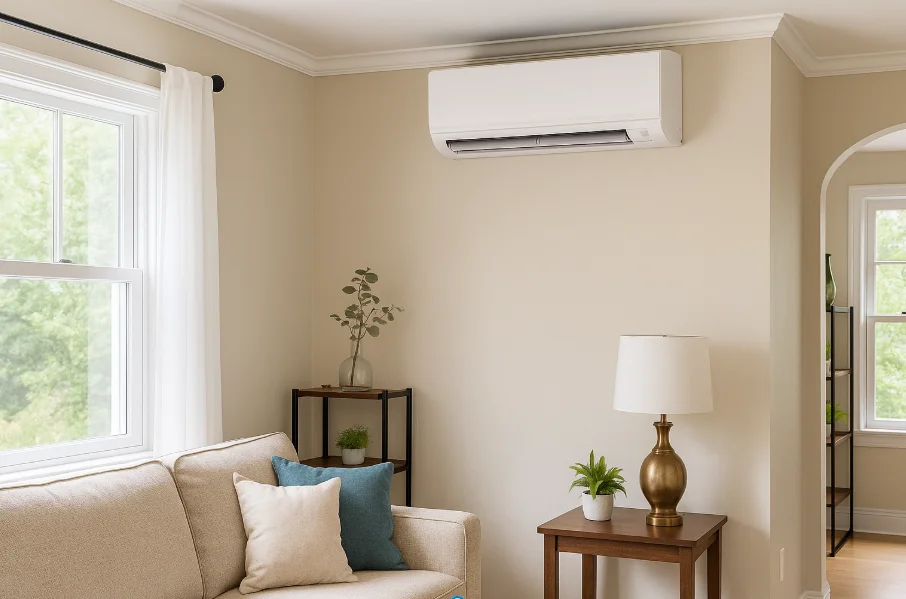Upgrading your home with a modern cooling system is more than a matter of comfort—it’s an investment that can influence your property’s value, energy efficiency, and long-term utility costs. For homeowners considering a sophisticated cooling solution, a Mitsubishi mini split is an increasingly popular choice. This type of system is designed to provide efficient, flexible cooling for both small and large spaces, making it suitable for a variety of residential setups. But beyond the initial installation, evaluating the long-term value involves understanding energy efficiency, installation considerations, ongoing maintenance, and the broader impact on your home improvement plans.
A cooling system is one of the central elements of home infrastructure. Selecting the right air conditioning unit requires balancing upfront costs, long-term energy savings, system lifespan, and the adaptability of the system to different rooms or zones. While traditional central air systems have long been the standard, ductless options such as Mitsubishi ductless mini splits offer unique advantages, particularly in homes that are older, lack existing ductwork, or require precise temperature control in specific zones.
Understanding the Benefits of Mini Split Systems
Mini split AC units are praised for their flexibility, energy efficiency, and relatively straightforward installation. Unlike conventional central air systems, which rely on an extensive duct network to distribute cool air, ductless mini splits operate via a network of compact indoor units connected to a single outdoor condenser. This setup allows homeowners to control temperatures in individual rooms independently, which can result in significant energy savings, especially in homes with uneven cooling needs.
One of the main advantages of these systems is their adaptability. For example, in a home undergoing renovations, installing a traditional central air system might require extensive remodeling to accommodate ductwork. A home air conditioner like a ductless mini split bypasses that challenge, enabling efficient cooling without major structural modifications. This ease of installation can also reduce labor costs and installation time, which adds to the system’s overall value proposition.
Energy efficiency is another critical factor. Mini splits often feature inverter-driven compressors that adjust cooling output dynamically, maintaining optimal temperature levels while minimizing energy waste. Over time, the energy savings from using a highly efficient system can offset the higher initial cost compared to a standard AC unit. Furthermore, many mini split models include advanced features such as programmable thermostats, remote control via smartphone apps, and compatibility with smart home systems, enhancing both convenience and energy management.
Long-Term Financial Considerations
While the upfront investment in a mini split system is typically higher than that of a traditional AC unit, several financial factors contribute to its long-term value. Reduced energy consumption, for example, translates into lower monthly utility bills. Homeowners who prioritize energy efficiency not only enjoy cost savings but may also benefit from local tax incentives, rebates, or credits for installing high-efficiency equipment.
Maintenance costs are another consideration. Mini split systems generally have fewer mechanical components exposed to wear and tear than traditional ducted systems, which can mean lower repair expenses over time. Filters are easier to access and clean, and the modular nature of the system allows for targeted maintenance without shutting down the entire home’s cooling infrastructure. This reduced downtime can be particularly valuable in households where consistent climate control is necessary for comfort, health, or preserving temperature-sensitive belongings.
Another long-term financial benefit lies in home resale value. Modern HVAC solutions are increasingly considered desirable by prospective buyers. A home equipped with a high-efficiency mini split AC unit can stand out in the market, particularly in regions with hot or humid climates. Potential buyers often perceive these systems as indicators of thoughtful home improvement and lower anticipated utility costs, which can enhance both appeal and property value.
Balancing Upfront Costs and Energy Efficiency
Investing in a mini split system requires balancing upfront costs against long-term savings. While the initial purchase price and installation can be substantial, the energy efficiency, zoning flexibility, and reduced maintenance costs often justify the investment. Homeowners need to evaluate their current energy usage, the size of their home, and the cooling demands of each room. A larger property with multiple zones will benefit more from the precise control of ductless systems than a smaller, uniformly cooled home.
It’s also important to consider the lifespan of the equipment. Many high-quality mini split units are designed to last 15–20 years when properly maintained. Over this period, the energy savings and reduced maintenance costs can significantly exceed the initial expenditure, especially when compared to less efficient, older systems. In this sense, investing in a Mitsubishi ductless mini split is akin to a long-term home improvement strategy, providing measurable financial and comfort benefits over decades.
However, homeowners should be aware of potential trade-offs. A ductless system requires multiple indoor units to cool an entire home effectively, which can increase installation costs. In some cases, aesthetic concerns arise, as wall-mounted units may not blend seamlessly with interior design. Additionally, the upfront cost of purchasing multiple units for larger homes may be prohibitive for some budgets, necessitating careful planning to balance initial expense with projected energy savings.
Installation Considerations
The installation process is critical to the performance and longevity of a mini split system. Unlike traditional AC units, which rely on pre-existing ductwork, ductless systems are more modular. This flexibility allows for installation in a variety of home layouts, but careful planning is required to ensure optimal airflow and efficiency.
Placement of the indoor units is crucial. They should be installed in areas that maximize cooling effectiveness without creating drafts or uneven temperatures. The outdoor condenser must also be positioned with proper ventilation to prevent overheating and ensure efficient operation. Professional installation is often recommended, especially for larger homes or multi-zone systems, as improper setup can reduce efficiency and increase maintenance needs.
Electrical considerations also come into play. Mini splits require dedicated power lines and may necessitate upgrades to the home’s electrical panel, particularly for older properties. While these additional steps add to the initial investment, they are essential for the safe and efficient operation of the system.
Impact on Home Comfort and Lifestyle
Beyond the financial and technical aspects, a ductless mini split significantly influences day-to-day comfort and lifestyle. Homeowners can adjust temperatures in individual rooms according to personal preference, enhancing comfort for all household members. Bedrooms, offices, and living areas can each be maintained at ideal temperatures without impacting the entire home, a flexibility that traditional systems struggle to provide.
Noise levels are another important consideration. Mini split AC units tend to operate more quietly than conventional systems, allowing for uninterrupted sleep, work, or leisure activities. The quiet operation, combined with precise temperature control, enhances the overall living environment and contributes to a perception of quality and modernity in the home.
The integration of smart features further enhances convenience. Many units now offer mobile app control, voice command compatibility, and scheduling options. Homeowners can pre-cool rooms before arriving, adjust settings remotely, or monitor energy usage, making climate management both efficient and user-friendly. These lifestyle benefits, while intangible, add significant value to the investment by improving day-to-day living conditions.
Challenges and Trade-Offs
While the long-term benefits of a ductless mini split are clear, there are challenges homeowners should consider. The higher initial cost is the most obvious barrier, particularly when multiple indoor units are required for larger homes. This cost can be offset over time through energy savings and reduced maintenance, but it requires a longer-term perspective and careful budgeting.
Aesthetic considerations can also be a factor. Wall-mounted units, while functional, are visible within rooms. For homeowners focused on interior design, this may necessitate creative placement or additional decorative solutions. Ceiling-mounted or concealed options are available but typically come at a higher cost.
Another challenge is the learning curve associated with operating multiple zones. Homeowners must understand how to manage different indoor units to optimize efficiency without overcooling certain areas. While modern controls are intuitive, achieving the perfect balance can require some trial and error.
Comparing Mini Splits to Traditional Air Conditioning Options
When considering home improvement, it’s important to compare mini splits to other cooling options. Traditional central air systems provide uniform cooling but often lack the flexibility and energy efficiency of ductless systems. Homes without existing ductwork face high renovation costs to accommodate central systems, whereas ductless mini splits can be installed with minimal disruption.
Window units and portable air conditioners are more affordable initially but fall short in long-term efficiency, comfort, and property value enhancement. These systems often consume more energy and may require replacement sooner, resulting in higher lifecycle costs. In contrast, investing in a high-quality mini split AC unit is a more sustainable and long-term solution.
Maximizing the Value of Your Investment
To maximize the long-term value of a mini split system, homeowners should focus on proper sizing, professional installation, and routine maintenance. Correctly sized units ensure optimal efficiency, prevent overcooling or undercooling, and reduce wear on the system. Professional installation minimizes potential issues and guarantees the system operates as intended.
Regular maintenance is essential. Cleaning filters, inspecting components, and scheduling professional servicing extend the life of the system and preserve energy efficiency. These actions protect the homeowner’s investment while ensuring consistent comfort over time.
Additionally, integrating the mini split into broader home improvement plans, such as insulation upgrades or smart home enhancements, can further improve energy efficiency and comfort. When paired with high-performance windows, proper sealing, and energy-conscious behaviors, the system delivers maximum benefit, reinforcing its value as a home improvement investment.
Wrapping Up
Investing in a Mitsubishi mini split air conditioning unit is more than a functional upgrade—it’s a strategic home improvement decision that offers long-term value in comfort, efficiency, and property appeal. While upfront costs may be higher than traditional AC options, the benefits of energy efficiency, flexible zoning, quiet operation, and potential increases in resale value make mini split systems a compelling choice for modern homeowners.
Balancing the trade-offs—such as initial investment, aesthetic considerations, and learning to manage multiple zones—requires careful planning, but the long-term gains often outweigh these challenges. For homeowners looking to enhance their living environment, reduce energy costs, and invest in a cooling system designed to last decades, a high-quality mini split AC unit represents a smart and sustainable solution. By approaching installation thoughtfully and maintaining the system properly, homeowners can ensure that this investment delivers consistent comfort and value for years to come.
There’s plenty more where that came from—browse our other helpful content!







